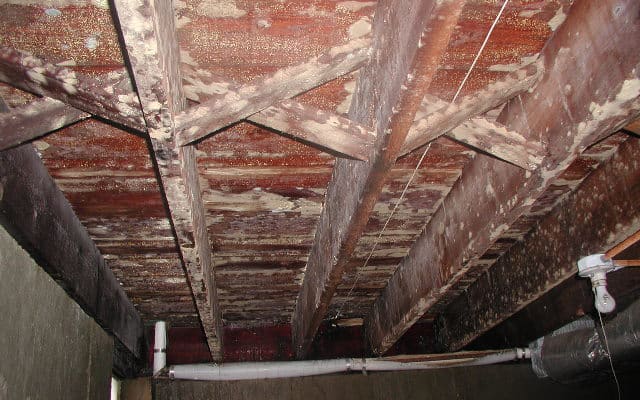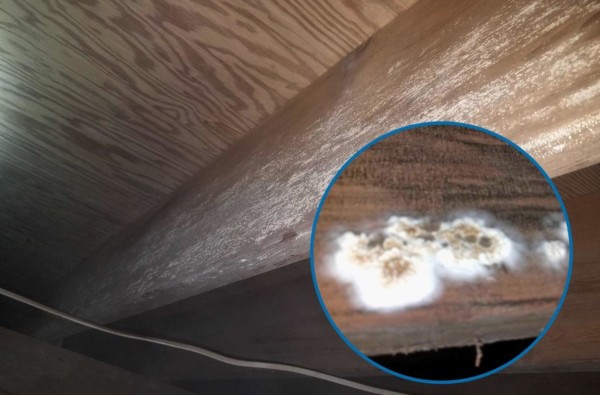Many people do not even realize they have a crawl space beneath their home, let alone have a look inside. While this space is meant to elevate the home’s wooden structure from the ground beneath and provide access for some utility engineers, it is also a breeding ground for toxic mold. Is your home vulnerable to an outbreak? What should you expect, and should you be thinking about crawl space mold removal?

Why Does Mold Accumulate?
For mold to flourish, it simply requires a damp environment and access to a food source. A typical crawl space is ventilated, and there is little to stop warm, moisture-laden air from entering. If left unchecked, the mold can quickly take hold and feed off the exposed timber and soil. Microscopic spores will break away and penetrate through tiny cracks and fissures into the living space above.
Challenging Problem
It’s difficult to keep moisture levels low in a typical crawl space for several reasons. To begin with, moisture tends to travel upward from the ground below, especially if the builders did not install a vapor barrier. Sometimes, condensation can build up on the outside of pipes that may also crisscross this area.
Three Types of Mold
While there are many different types of mold, three are most likely to set up a home in your crawl space.
Black
Black mold is the most toxic, with the highest levels of mycotoxins. It has a powdery or fuzzy appearance. Some people refer to this as the “toxic” mold, although all types of mold can lead to symptoms in sensitive people. Strangely, black mold can have a green appearance and may also have a distinctive odor. It tends to grow in clusters and can quickly colonize an area once it takes hold. All it needs is some moisture and a source of food, together with generally warm or humid conditions.
Yellow
Yellow mold can cause the most damage to the wooden infrastructure of the building. It attaches to the structures and has a “flat” appearance. There are many different types of yellow mold, some of which can be intensely yellow, while others may have a “slimier” consistency. Some experts claim that this type of mold is a single-cell organism rather than a fungus, but you won’t want it around either way. Some types of yellow mold actually turn gray as they get more mature.
White
White mold has a fuzzy appearance and tends to sprout on top of exposed soil. It also likes to feed on damp, wooden joists. White mold can grow readily in a crawl space, and while it may not be as potentially toxic as black mold, it can still produce toxins and should be eliminated.
To grow, mold needs both moisture and a food source. Unfortunately, the typical crawl space has high humidity and moisture levels, while wooden beams and joists represent a good food source. White mold can also feed off any exposed soil in the crawl space.
Health Risks
As the mold grows and the spores find their way into the home above, sensitive individuals may suffer. They may inhale the spores and could start to cough, sneeze or find difficulty breathing. They may develop a stuffy or runny nose, itchy and red eyes, or itchy skin. Those with asthma or a complex allergy could develop an even more serious reaction.
But how long does it take to show signs that you may be suffering from mold inhalation? According to experts, it depends on the sensitivity of the individual. If people naturally have an allergy to mold, then the immune system will go into overdrive when exposed, and this can happen immediately. Also, sickness may depend on the amount of mold present, with the greater the infestation, the larger the risk. And, if you spend a lot of time indoors, your risk for exposure goes up, thus increasing the chance that symptoms may develop.
No amount of mold is acceptable in a crawl space. In addition to the health risks for those who live above, a mold infestation can lead to decay and wood rot. It could also cause wooden floors to warp and paper to peel off the wall, so you need to take action to remove it as soon as possible.

Treating Mold
Several spray-based products on the market are designed to kill a mold infestation, but you should approach them with care. Some contain harsh chemicals and may only act as a temporary measure, especially if not applied correctly. If you suspect an infestation, it’s best to turn over the problem to professionals.
Mold that forms within joists can be particularly tricky to remove. It may be possible to use a simple solution of vinegar and water with a touch of bleach, but you’ll want to remove the cause of the mold in the first place. Otherwise, it will simply return.
Crawl Space Mold Removal
To begin the mold removal process, you need to:
- Carefully inspect the crawl space to determine the full extent of the problem.
- Take care of any conditions that can trigger mold growth.
- Repair any leaking pipes or eliminate the risk of flooding after a rainstorm.
- If necessary, introduce a plastic vapor barrier to encapsulate the space.
- Repair or replace any decaying wood.
Luckily, we have a team of skilled experts here at Moisture Loc to get it all done for you. Our team uses the newest step in mold remediation to take care of your home: dry ice blasting. This safe, environmentally friendly method clears away mold without any harsh chemicals. We only use the leading technology in the industry in order to provide you with superior service and notable results.
What to Do Next
A quick search on the internet will generate a variety of answers, but everything will depend on the type of mold, the size of the infestation, the underlying cause, and general accessibility. Talk with a mold removal expert to get a definitive price.
So, if you suspect that mold has taken over your crawl space, you should talk to us soon. Get in touch with Moisture Loc and schedule an inspection as soon as possible.

